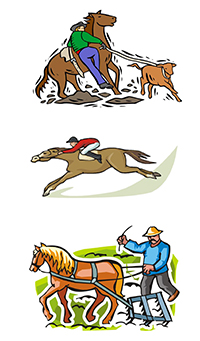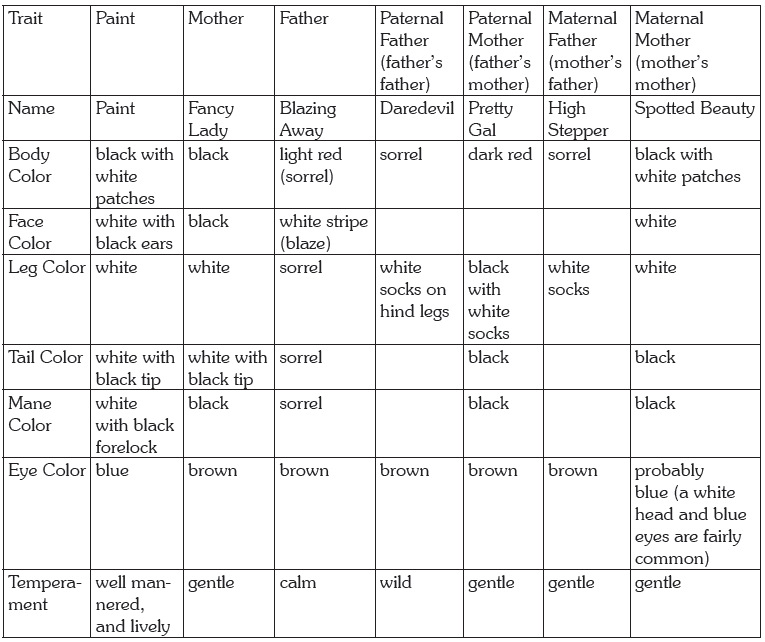Agricultural Literacy Curriculum Matrix
Lesson Plan
Paint's Family Tree
Grade Level
Purpose
Students explore the complexity of heredity by studying horses and creating a horse’s family tree. Grades 3-5
Estimated Time
Materials Needed
Engage:
- Illustrations of Working Horses for display
Activity 1
- Paint’s Family Tree Skit dialogue, 1 per student
- Trait Summary activity sheet, 1 per student
- Paint’s Family Tree activity sheet, 1 per pair of students
- Paint’s Family Tree Master for display (it may be helpful to color this)
- Family Tree Horse activity sheet, 1 per student
- 1 large sheet of butcher or chart paper
- Glue, glue sticks, or tape
- Colored pencils for each team of students
Vocabulary
draft horse: a large horse used for pulling heavy loads, especially a cart or plow
inherited: derive a quality or characteristic genetically from one's parent or ancestors
offspring: the child or young of two parents
Thoroughbred: a breed of horse that is used mainly for racing
trait: observable, physical characteristic obtained through genetic inheritance
Did You Know?
- Horses have lived on Earth for more than 50 million years.1
- It is believed that horses were first domesticated in Central Asia around 4000 BC for meat and milk.2
- Today, there are more than 400 different breeds of horses.1
Background Agricultural Connections
For thousands of years, livestock and crop plants have been selectively bred to perpetuate desirable characteristics. Although early agriculturalists did not understand genetics like we do today, they were able to observe that plants and animals tend to exhibit traits similar to those of their parents. By carefully choosing which plants to save seeds from and which animals to save for breeding, people have domesticated and improved the agricultural qualities of numerous plants and animals. Today, modern technology allows plant and animal breeders to more precisely select for desirable traits and more rapidly develop new traits, but the basic pattern of offspring exhibiting traits inherited from their parents is still at the foundation of all breeding programs.
Horse breeders are very aware of family traits. The traits for which they breed horses can be visible, such as hair coloring and muscularity, or invisible, such as temperament and health characteristics. Over time, different breeds of horses have been developed to excel at different types of work. For example, there are many breeds of draft horses, which are large, muscular, calm, and gentle animals. These traits make them well adapted for working with people and pulling heavy loads. For many years, horses were the main source of power for tilling fields and for transportation of people and materials. Today, draft horses are still widely used to pull sightseers in carriages, and some farmers even continue to use horses to work their fields, although tractors get the work done much more quickly.
In contrast to draft horses, Thoroughbreds are a specific breed that has been selected specifically for racing. Horse racing is an ancient sport and has probably been practiced for as long as horses have been domesticated. The Thoroughbred was developed in 18th century Britain for speed and stamina. These horses are often considered “hot-blooded” and spirited. They are the most highly valued breed of horse today. Thoroughbreds are often used in crossbreeding to create new breeds or improve existing breeds.
Engage

- Show students the Illustrations of Working Horses, and ask them to describe the type of work each horse is doing.
- As a class, brainstorm what characteristics would make a horse good at each type of work, and write them on the board. For example, a horse that helps herd cows needs to be agile and good at working with people, cows, dogs, and other horses; a racehorse needs to be fast and have good stamina; and a draft horse needs to be strong, willing to work, and easy to handle.
- Explain to students that over time, people have selectively bred horses for specialized traits that make them suited for certain kinds of work. In order to breed horses to meet specific objectives, it is important to understand how traits are passed from parents to offspring, and that is what will be explored in this lesson.
Explore and Explain
Activity 1
- Choose four students (two girls and two boys) to play the roles in the skit, Paint’s Family Tree. Have them read and act out the skit.
- Give each student a copy of the skit and a Trait Summary activity sheet. Allow students to read the skit and fill out the activity sheet individually.
- After students have completed the Trait Summary, break them up into pairs.
- Give each pair of students a copy of the Paint’s Family Tree activity sheet. Have them color this sheet according to how they filled out the information on the Trait Summary activity sheet. They should also label each horse with its name and relationship to Paint (see Paint’s Family Tree Master). Doing this in pairs will help students to correct any mistakes they may have made on the Trait Summary activity sheet.
- Next, divide the students into seven groups, and give each group a Family Tree Horse activity sheet. Assign each group a different member of Paint’s family. The group must come to a consensus on how to color their family member using their previously colored family trees. They may need to refer back to the skit for verification.
- When each group is finished, review with them the Paint’s Family Tree Master. Students may have put socks and spots in different places; that’s okay. (When horses are registered in the “real world,” the spots and socks are noted while looking at the horse so that the markings are accurate. This illustration then becomes part of the horse’s registration). Have the groups make corrections to their horses’ colors and markings only if they are obviously wrong; if not, proceed to the next step.
- Post the large sheet of butcher or chart paper in an accessible location. Have each group place their horse on the paper in the appropriate location to form a family tree. Ask the group to describe their horse’s traits. Have students draw lines between the horses to show lines of descent between generations.
- As a class, discuss the similarities and differences in traits among the family members and how each trait might have been inherited. Point out to students that traits are inherited from both parents. However, these traits are not always expressed in every generation (such as the blue eyes that Paint and his maternal grandmother have). Consider using the following questions to further the discussion:
- What traits were unique to Paint?
- Can you name other inherited traits that may not be visible?
- From which relatives did Paint get the black on his tail and mane? His white face? His temperament?
- If another animal (pig, chicken, cow, etc.) were chosen, would you be able to determine from which parent its traits may have been inherited? How would you do it?
- Imagine that Kuan’s family ranch wants to start giving tours using horse-drawn wagons. What characteristics would make their horses suited to this kind of work? What could they do to make sure that the next generation of horses is well suited to pulling wagons?
Elaborate
-
Invite a horse breeder to come to your class as a guest speaker.
-
Further explore the use of draft horses by showing students the video Introduction to Draft Animal Power from the Cornell Small Farms Program.
Evaluate
After conducting these activities, review and summarize the following key concepts:
- Traits are passed from parents to offspring.
- Ranchers and farmers use knowledge of inherited traits to breed animals like horses to meet specific objectives.
Sources
- http://www.livescience.com/50714-horse-facts.html
- http://www.ansi.okstate.edu/breeds/horses/
Acknowledgements
This lesson was adapted with permission from California Agriculture in the Classroom's unit Where'd You Get Those Genes for Grades 5-7.
Recommended Companion Resources
Author
Organization
| We welcome your feedback! If you have a question about this lesson or would like to report a broken link, please send us an email. If you have used this lesson and are willing to share your experience, we will provide you with a coupon code for 10% off your next purchase at AgClassroomStore. |

